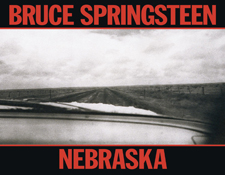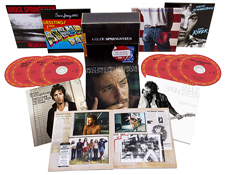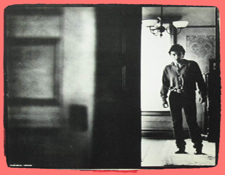It’s the time of year for saving money!
Back in the day, I decided I really liked Bruce Springsteen’s Nebraska when the album came to the end of the song “State Trooper.” It is that point just before the fade when Bruce sings “hi ho silver-o, deliver me from nowhere” and then he lets loose with a spine-tingling scream that clearly sent the VU meters of his Tascam Portastudio into the red.
 That sweet sweet distortion — emotive, over-the-top and not at all harsh — made that take the keeper and got me into the spirit of the album. Thirty-plus years down the line, listening with fresh ears in 20/20 hindsight, that moment of purely analog, tape-saturated distortion is still a wonder and something you don’t get to hear much anymore on recordings made with modern digital recorders.
That sweet sweet distortion — emotive, over-the-top and not at all harsh — made that take the keeper and got me into the spirit of the album. Thirty-plus years down the line, listening with fresh ears in 20/20 hindsight, that moment of purely analog, tape-saturated distortion is still a wonder and something you don’t get to hear much anymore on recordings made with modern digital recorders.
The distortion you get today is either super neat and tidy or you get a wash of gritty “pfffffmmmmphfffttt”-sounding digital mush (i.e., a lot of the texture one hears in current dance music). Sure there are software “plug ins” which let you simulate analog tape saturation effect (and they are cool!) but in those situations there you (the artist) are planning too much for it as “an effect.”
You see, there is something special about those happily unplanned accidents that make moments like this on “State Trooper” ring more true to the heart artistically.
I’m purely guessing here, but I’d like to think that when making Nebraska, Bruce was riding his recording levels up good’n’high to make the most of the four-track cassette format and minimize the amount of inherent tape hiss that would be revealed. And just like the characters in many of his songs, he just took it all just a bit over that edge.
The rest of the take was so good and the distortion just felt so right… capturing that essence of a spirit crying out in the night… it had to become the keeper for the album.
I say all this because I am approaching this review of Nebraska as reproduced on two different digital formats: compact disc (available separately or in a box set shown below) and high-resolution download. The layman music fan within me initially automatically figured that the CD would be “good enough” to capture the essence of an LP made on a sonically limited four-track cassette recorder.
My inner layman was wrong.
Curiously enough, the CD is indeed revealing some details which were clearly accounted for (if you will) differently in the mastering of the original LP. Listen for the distortion on the title track on Bruce’s vocals, which on LP is relatively understated and fits like a glove in the mix without calling much attention to it. On the CD that distortion is very much more apparent and in your face (especially at around the 50-second mark when Bruce sings “me and her went ferrrr a riiiiiide sir….”).
I’m not saying this is a bad. I am just saying it is there. Nebraska was always supposed to be a sort of impromptu warts’n’all affair so now with this new remaster here you are getting to hear some more of the warts!
 Call them what you may… sonic anomalies… whatever…
Call them what you may… sonic anomalies… whatever…
Overall, the CD sounds real nice, with just occasional moments of seeming digital harshness on the high end. It is admittedly a little hard to tell what is what at times since this album was recorded on cassette — a format which brings with it its own set of wows, flutters, distortions, magnetic tape-recording-inconsistancy issues, etc. — but I’m doing my best to discern some of these nuances for you, Dear Readers! I do know that Bruce and his team of audio wizards put Nebraska through the Plangent Processes treatment to help remove some of these ill-effects imposed on the music from the consumer-grade multitrack cassette recording medium.
Now, one of the reasons I chose to review Nebraska is that the HDTracks version is available in 24-bit/192-kilohertz resolution. That is effectively four times the sonic size of a CD. Going back to “State Trooper,” I immediately “get” the reason for Bruce putting this out as such a super-high-resolution download. This version sounds way, way bigger than the CD, with all the warmth of LP yet far more clarity and definition.
]]>Bruce’s acoustic guitar sounds round and full, and the recording is so intimate you can hear his fingers wiping across the steel strings. His voice is generally bathed in a bit of reverb/slap, but still sounds like he’s in the room with you. There are nice details on “State Trooper” where you begin to feel the pressure of Bruce’s palm as he mutes the strings of his guitar, and you can detect the slight scrape of his pick on the strings.
And there is that scream…. sounds amazing!
Now you are a fly-on-the-pickguard sitting right next to Bruce’s acoustic guitar. Some call this a “close mic” recording technique, and it’s one that lets you almost reach inside the guitar.
It’s really apparent as Bruce chugs out those Chuck Berry-like bluesy riffs… you’re sitting right there in the palm of Bruce’s hand against the strings…
“Atlantic City” also has much more presence on it via the HDTracks high-resolution download. On the CD it sounds good, but you aren’t getting all that fat round tone of Bruce’s acoustic guitar that you hear on the high-res download.
 And so it goes that way throughout the rest of the album.
And so it goes that way throughout the rest of the album.
Nebraska gave us a raw taste of Bruce Springsteen stripped down and musically naked, years before the whole “unplugged” phenomenon. This album set the stage for his stylistic crossover from rock and pop to include country, folk, blues and gospel elements into his songwriting. It is a much more important transitional album than it appears on the surface, bridging the gap from his early 1970s folk troubadour coffeehouse (breakthroughs before being discovered and signed to a major label) to the grand musical statesman for a generation that he would shortly become.
And now you can hear all this fine and stirring music in a fidelity that you really wouldn’t expect from a cassette multi-tracker.
Never thought I’d be saying this but in retrospect I see that Nebraska is an essential album in the Springsteen catalog, so do check it out. Lo-fi has never sounded better.






